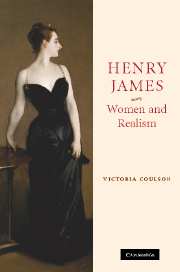Book contents
- Frontmatter
- Contents
- Acknowledgements
- List of abbreviations
- Introduction: ambivalent realism
- Chapter 1 Alice James and the portrait heroine
- Chapter 2 The actress and the orphan: Henry James's art of loss, 1882–1895
- Chapter 3 Teacups and love letters: Constance Fenimore Woolson and Henry James
- Chapter 4 Realism and interior design: Edith Wharton and Henry James
- Epilogue: 1892
- Notes
- Bibliography
- Index
Chapter 4 - Realism and interior design: Edith Wharton and Henry James
Published online by Cambridge University Press: 22 September 2009
- Frontmatter
- Contents
- Acknowledgements
- List of abbreviations
- Introduction: ambivalent realism
- Chapter 1 Alice James and the portrait heroine
- Chapter 2 The actress and the orphan: Henry James's art of loss, 1882–1895
- Chapter 3 Teacups and love letters: Constance Fenimore Woolson and Henry James
- Chapter 4 Realism and interior design: Edith Wharton and Henry James
- Epilogue: 1892
- Notes
- Bibliography
- Index
Summary
[W]ith no worlds left to conquer … and no impression worth getting thereby remaining to you, doubtless, you must have recoiled and rebounded, charged with booty … [T]hese great globe-rushes and vast gyrations of yours lift you so, for me, far above mortal, or Lamb House, ken, and give me such a sense of the rate at which you are living, learning, plundering and pillaging, that the whole adventure makes me crouch in terror or at least in humility, as by its mere side-wind.
(Henry James to Edith Wharton, 6th September 1913, HJ/EW 263)In his correspondence with Edith Wharton, Henry James represents himself as lacking in resources, flagging and failing, breathless in her triumphal wake. ‘Ah I'm conscious enough, I assure you, of going without, and of all the rich arrears that will never – for me – be made up – !’ It is his misfortune that he cannot keep up with her, his ‘ideal of the dashing Woman’; he can only ‘hang about [her] by the power of participation supersensual and devotional’. From the melancholy tranquillity of his bachelor quarters, Henry contemplates the splendours of Edith's Paris apartment, ‘hover[ing], like a too participant larbin, behind your Louis XIV chair (if it isn't, your chair, Louis Quatorze, at least your larbin takes it so)’; he cannot visit the rue de Varenne, ‘But, ah, how from the shelf I shall watch you on the Aubusson carpet!’
Henry was immensely fond of his ‘dearest Edith’, and with good reason: she was a loyal friend for fifteen years.
- Type
- Chapter
- Information
- Henry James, Women and Realism , pp. 141 - 189Publisher: Cambridge University PressPrint publication year: 2007



